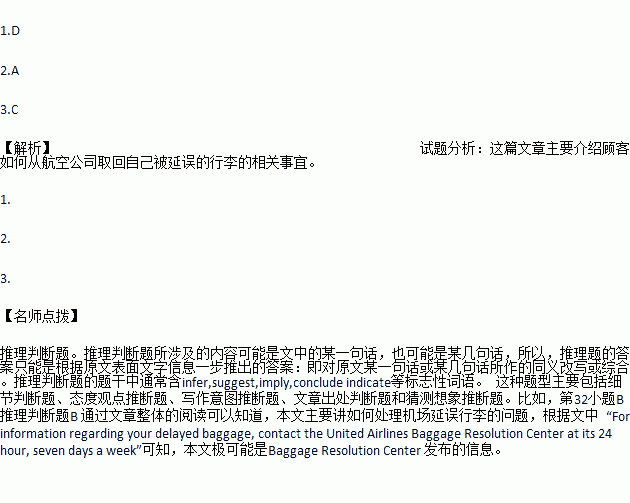题目内容
File Created Page 1 of 1
 DELAYED BAGGAGE REPORT
DELAYED BAGGAGE REPORT
PRINTED AT ALBANY N.Y. AIRPORT ON JULY 10, 2016 11:15 A.M.
Dear Valued Customer,
We regret that your baggage was not available to claim after your recent flight. Everything possible will be done to locate your belongings and return it to you on time.
For information on your delayed baggage, contact the United Airlines Baggage Resolution Center at its 24 hour, seven days a week.
Number:
1-800-335-BAGS (2247) (US – Toll Free)
281-821-3536 (Local Houston Number)
Or visit site: http://www.united.com/for/bagtracing
As soon as you send your Delayed Baggage Report, United Airlines will begin to look carefully for your baggage system. Our Baggage Resolution staff will make every effort to call you once a day to keep you updated on our progress. Please refer to the File Reference Number on this receipt (凭证) when corresponding or calling so that we can quickly access your records.
Keep this receipt with your claim check (提取证)and E-Ticket receipt until your baggage is returned to you.
In most circumstances, United Airlines will deliver your baggage when it is located. Delivery times vary depending on location.
If your baggage has not been returned to you within the first five-day tracing period, please download a claim form from our website and return it to us with the required information included.
DELAYED BAGGAGE REPORT
DELAYED BAGGAGE REPORT FILE REFERENCE: ALBUA25876
Name: JOHN JACKSON Contact Number: 802-247-9999
Delivery Address: 66 MOONBROOK DR
BRANDON Email: minminvt@yahoo.com
VERMONT USA 05745
Bag Tag: 0037387643; 0037387657
Description: Soft-Side Upright suitcase; Non-Zippered, hard side horizontal suitcase
1.Where does the report most probably come from?
A. Suitcase Tracing Center B. Information Center of the Airport
C. Delivery Center of United Airline D. Baggage Resolution Center
2.What can we learn about John Jackson from the report?
A. He must have filed his Delayed Baggage already.
B. He will get back his delayed baggage in less than five days.
C. He should call 802-247-9999 for the information about his delayed baggage.
D. He may not know anything about his delayed baggage during the first five days.
3.The purpose of the passage is __________.
A. to provide information about the location of the delayed baggage
B. to inform the customers of the time when the delayed baggage can be found
C. to instruct the customers how to get back their delayed baggage
D. to tell the customers the news that their delayed baggage was delayed


 ced all the ignorance in me with ________. Then she opened my ________ and opened it even wider. She would find time to turn me into a ________ signer. She taught me that there are no limits and my abilities are ________.
ced all the ignorance in me with ________. Then she opened my ________ and opened it even wider. She would find time to turn me into a ________ signer. She taught me that there are no limits and my abilities are ________.